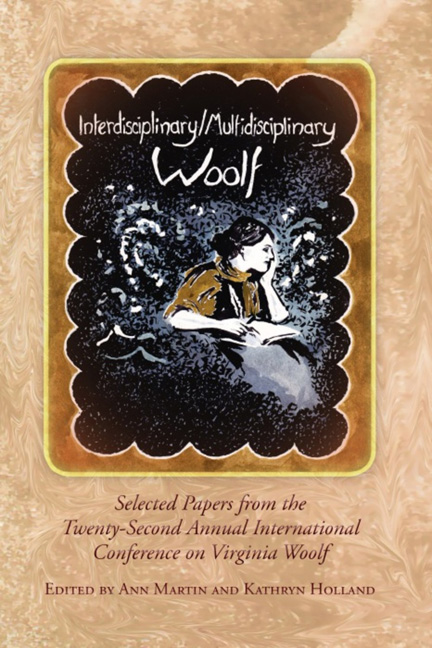Book contents
- Frontmatter
- Contents
- Introduction to Interdisciplinary/Multidisciplinary Woolf
- Acknowledgments
- List of Abbreviations
- History, Materiality, Multiplicity
- Patterns, Practices, Principles
- “Waving to Virginia”
- Woolf, Defoe, Derrida: Interdisciplinary dogs—or the canine aesthetics and (gender) politics of creativity
- “The law is on the side of the normal”: Virginia Woolf as Crip Theorist
- A Healing Centre of One's Own: Woolf's Legacy and Public Responses to Child Abuse
- Sunflower Suture: Disseminating the Garden in The Years
- “One Must Be Scientific”: Natural History and Ecology in Mrs. Dalloway
- Clarissa's Glacial Skepticism: John Tyndall and “Deep Time” in Mrs. Dalloway
- Apollonian Illusion and Dionysian Truth in Mrs. Dalloway
- Art, Influence, Embodiment
- Publishing, Politics, Publics
- Notes on Contributors
- Conference Program
“The law is on the side of the normal”: Virginia Woolf as Crip Theorist
from Patterns, Practices, Principles
- Frontmatter
- Contents
- Introduction to Interdisciplinary/Multidisciplinary Woolf
- Acknowledgments
- List of Abbreviations
- History, Materiality, Multiplicity
- Patterns, Practices, Principles
- “Waving to Virginia”
- Woolf, Defoe, Derrida: Interdisciplinary dogs—or the canine aesthetics and (gender) politics of creativity
- “The law is on the side of the normal”: Virginia Woolf as Crip Theorist
- A Healing Centre of One's Own: Woolf's Legacy and Public Responses to Child Abuse
- Sunflower Suture: Disseminating the Garden in The Years
- “One Must Be Scientific”: Natural History and Ecology in Mrs. Dalloway
- Clarissa's Glacial Skepticism: John Tyndall and “Deep Time” in Mrs. Dalloway
- Apollonian Illusion and Dionysian Truth in Mrs. Dalloway
- Art, Influence, Embodiment
- Publishing, Politics, Publics
- Notes on Contributors
- Conference Program
Summary
Incomprehensibility has an enormous power over us in illness, more legitimately perhaps than the upright will allow. In health meaning has encroached upon sound. Our intelligence domineers over our senses. But in illness, with the police off duty, we creep beneath some obscure poems by Mallarmé or Donne, some phrase in Latin or Greek, and the words give out their scent and distil their flavor, and then, if at last we grasp the meaning, it is all richer for having come to us sensually first, by way of the palate and the nostrils, like some queer odour. (“On Being Ill” 19)
Iwant to take the opportunity presented by the conference theme of Interdisciplinary/ Multidisciplinary Woolf to think about Woolf from the perspective of critical disability studies, or what Robert McRuer has called “Crip Theory” in his 2006 book of that name. I do so in part because much has been written over the past several decades on Virginia Woolf's apparent mental illness—situating her according to either a medical model of disability conforming to what Eve Sedgwick calls a “minoritizing” conception of identity, or a constructionist model that conforms to what Sedgwick would call a “universalizing” conception of identity (40). That is, those who believe that Woolf's break-downs were congenital, for example the result of untreated (or mistreated) bipolar disorder, as Thomas Caramagno does, tend to understand Woolf from the perspective of a medical model of disability, as part of a unique and relatively small minority of people who share an immutable physiological characteristic (Caramagno 2). Those who read Woolf's breakdowns (including her suicide) as symptoms of traumatic abuse and dysfunctional family dynamics such as Louise DeSalvo does, imply that Woolf was just like everyone else, or would have been, if she were not literally driven mad by patriarchal gender norms and abuse. I don't want to dwell on this critical polarity overlong, as I have written about it elsewhere in relation to depictions of Woolf's mental illness, but it is worth reiterating Sedgwick's caution that neither a universalizing position (as in “we're all potentially queer” or “we're all potentially disabled”) nor a minoritizing position (as in the assertion that the queer person or the disabled person is “born this way”) guarantees a beneficent outcome (Detloff 25; Sedgwick 40).
- Type
- Chapter
- Information
- Interdisciplinary/Multidisciplinary Woolf , pp. 102 - 108Publisher: Liverpool University PressPrint publication year: 2013



